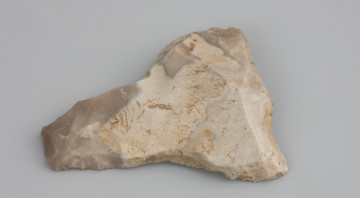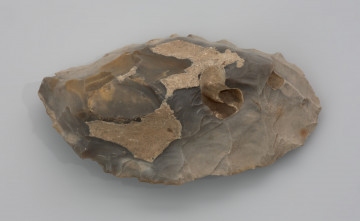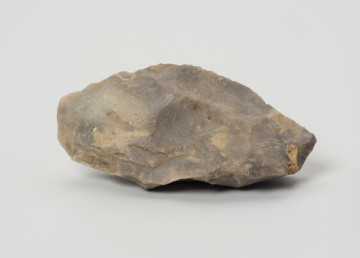
Flake axe
9600 p.n.e. — 9000 p.n.e.
National Museum in Szczecin
Part of the collection: Stone Age
The Oringe-type cylindrical axe from Tanowo, the Police district, comes from one of the essential Proto-Neolithic sites in West Pomerania. It was made of metamorphic rock, probably gneiss. The first production stage was the chipping of the initial form of the tool with a stone pestle. This stage was similar to that of flint tools and consisted in forming an elongated pre-form of the tool. Next, the half-form was shaped using the so-called pecking technique, i.e., pounding with a small hard stone, which caused slight chipping of the surface with each blow. Forming a tool using that technique was highly time-consuming, but it allowed it to be shaped more predictably than when it was split. The final stage was to grind and sharpen the blade. Significantly, the axe was planned so that the blade was formed on a thin layer of crystalline quartz. As a result, it was hard and very resistant to damage. It is usually assumed that the technology for making stone tools came to the southern Baltic coast through the Neolithic people (the first farmers), who represented the Danubian cultural circle. However, individual stone tools have been discovered in contexts dating to before contact with the Neolithic population. These are mainly associated with a technological tradition originating in Scandinavia, where stone raw materials were an alternative to flint.
Michał Adamczyk
Author / creator
Dimensions
cały obiekt: height: 11.3 cm, width: 4.1 cm
Object type
axe
Technique
pecking, grinding, hard masher carving
Material
stone
Origin / acquisition method
field research
Creation time / dating
Creation / finding place
Owner
National Museum in Szczecin
Identification number
Location / status

9600 p.n.e. — 9000 p.n.e.
National Museum in Szczecin

9600 p.n.e. — 5400 p.n.e.
National Museum in Szczecin

7800 p.n.e. — 7000 p.n.e.
National Museum in Szczecin
DISCOVER this TOPIC
Museum of King Jan III's Palace at Wilanów
DISCOVER this PATH
Educational path